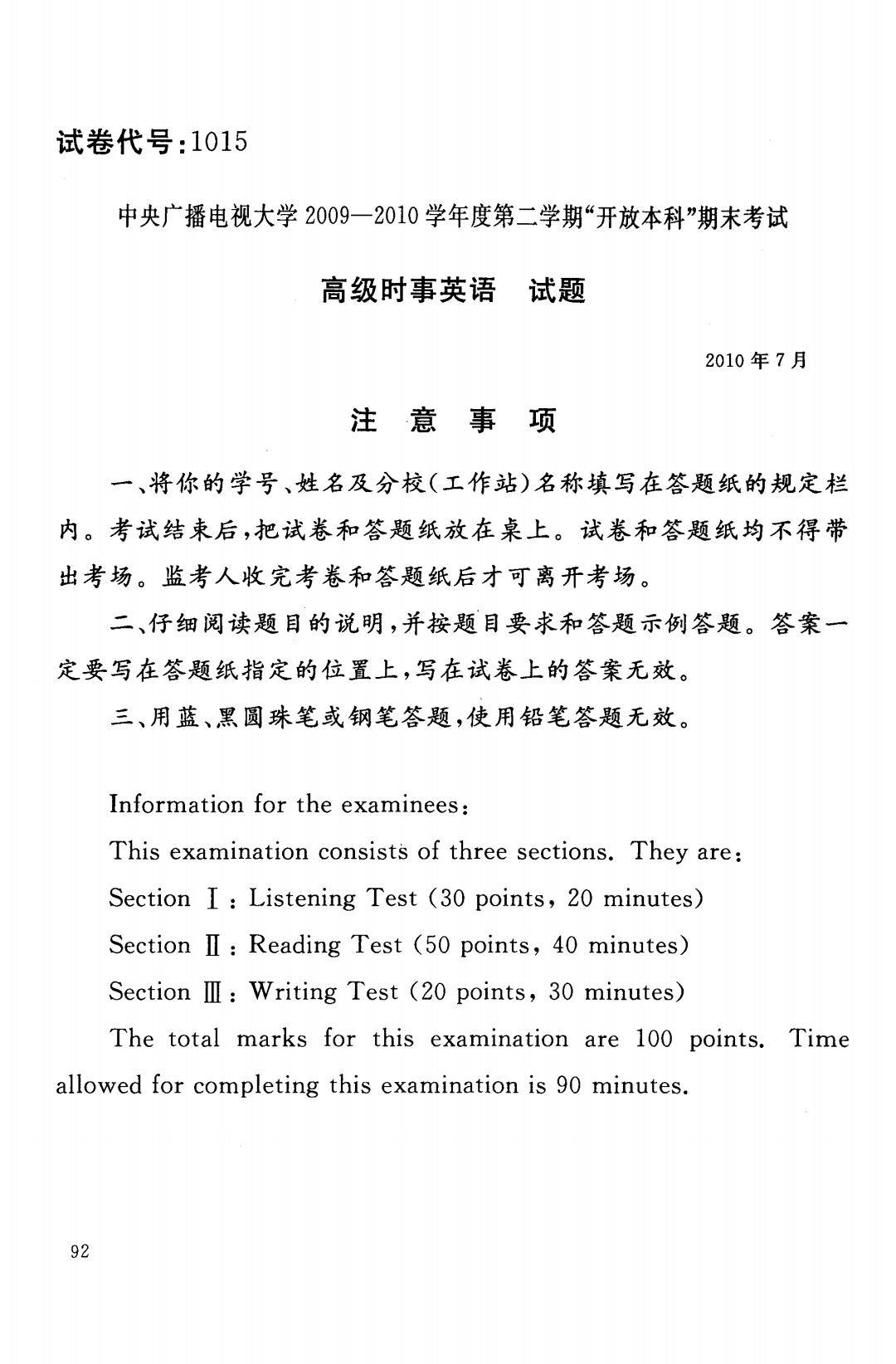
试卷代号:1015 中央广播电视大学2009一2010学年度第二学期“开放本科”期末考试 高级时事英语 试题 2010年7月 注意事项 一、将你的学号、姓名及分校(工作站)名称填写在答题纸的规定栏 内。考试结束后,把试卷和答题纸放在桌上。试卷和答题纸均不得带 出考场。监考人收完考卷和答题纸后才可离开考场。 二、仔细阅读题目的说明,并按题目要求和答题示例答题。答案一 定要写在答题纸指定的位置上,写在试卷上的答案无效。 三、用蓝、黑圆珠笔或钢笔答题,使用铅笔答题无效。 Information for the examinees: This examination consists of three sections.They are: Section I:Listening Test (30 points,20 minutes) Section II:Reading Test (50 points,40 minutes) Section IlI:Writing Test(20 points,30 minutes) The total marks for this examination are 100 points.Time allowed for completing this examination is 90 minutes. 92
试卷代号 中央广播电视大学 2 0 0 2010 学期 放本 末考试 高级时事英语试题 2010 年7 事项 一、将你的学号、姓名及分校(工作站)名称填写在答题纸的规定栏 内。考试结束后,把试卷和答题纸放在桌上。试卷和答题纸均不得带 出考场。监考人收完考卷和答题纸后才可离开考场。 二、仔细阅读题目的说明,并按题目要求和答题示例答题。答案一 定要写在答题纸指定的位置上,写在试卷上的答案无效。 三、用蓝、黑圆珠笔或钢笔答题,使用铅笔答题无效。 Information for the examinees: This examination consists of three sections. They are: Section I : Listening Test (30 points , 20 minutes) Section II : Reading Test (50 points, 40 minutes) Section ill: Writing Test (20 points , 30 minutes) The total marks for this examination are 100 points. Time allowed for completing this examination is 90 minutes. 92
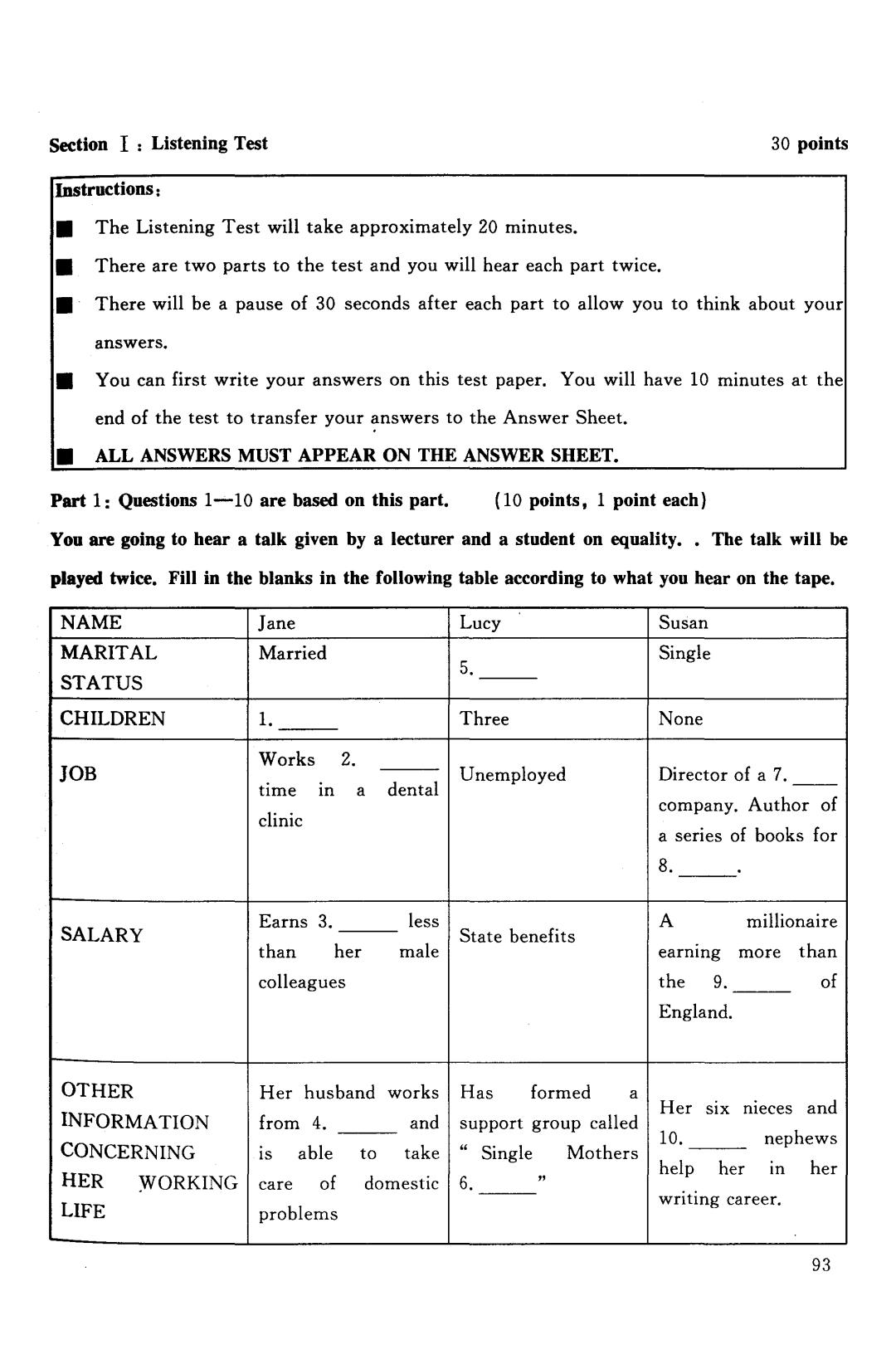
Section I:Listening Test 30 points Instructions: The Listening Test will take approximately 20 minutes. There are two parts to the test and you will hear each part twice. There will be a pause of 30 seconds after each part to allow you to think about your answers, You can first write your answers on this test paper.You will have 10 minutes at the end of the test to transfer your answers to the Answer Sheet. ALL ANSWERS MUST APPEAR ON THE ANSWER SHEET. Part 1:Questions 1-10 are based on this part. (10 points,1 point each) You are going to hear a talk given by a lecturer and a student on equality..The talk will be played twice.Fill in the blanks in the following table according to what you hear on the tape. NAME Jane Lucy Susan MARITAL Married Single 5. STATUS CHILDREN 1. Three None Works 2. JOB Unemployed Director of a 7. time in a dental company.Author of clinic a series of books for 8. " Earns 3. A millionaire SALARY less State benefits than her male earning more than colleagues the 9. of England. OTHER Her husband works Has formed INFORMATION Her six nieces and from 4. and support group called CONCERNING 10. “Single nephews is able to take Mothers help her in her HER WORKING care of domestic 6. LIFE writing career. problems 93
Section I : Listening Test Instr uctions: 30 points • The Listening Test will take approximately 20 minutes. are two parts to the test and you will hear each part twice. •. There will be a pause of 30 seconds after each part to allow you to think about your answers. • You can first write your answers on this test paper. You will have 10 minutes at the end of the test to transfer your answers to the Answer Sheet. • ALL ANSWERS MUST APPEAR ON THE ANSWER SHEET. Part 1: Questions 1---10 are based on this part. (10 points, 1 point each) You are going to hear a talk given by a lecturer and a student on equality. • The talk will be played twice. Fill in the blanks in the following table according to what you hear on the tape. NAME Jane Lucy Susan MARITAL Married Single 5. STATUS CHILDREN 1. Three None JOB Works 2. dental Unemployed Director of a 7. • • time in a clinic company. Author of a series of books for 8. • SALARY Earns 3. less A millionaire State benefits than her male earning than colleagues the 9. of England. OTHER Her husband works Has formed a INFORMATION Her six nieces and from 4. and support group called 10. nephews CONCERNING " Single • IS able to take Mothers help her • her HER in WORKING care of domestic 6. " • • LIFE problems wnting career. 93
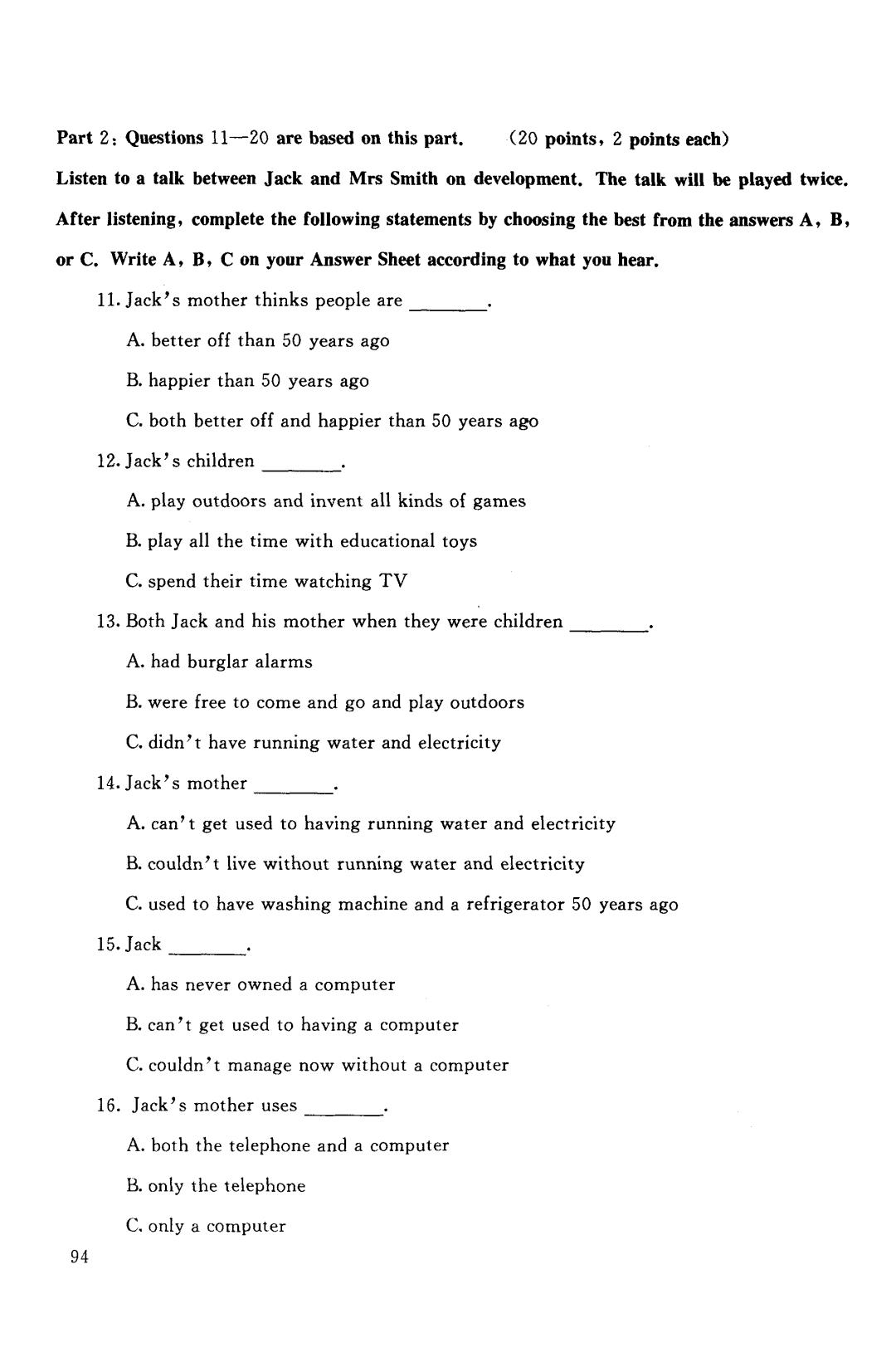
Part 2:Questions 11-20 are based on this part.(20 points,2 points each) Listen to a talk between Jack and Mrs Smith on development.The talk will be played twice. After listening,complete the following statements by choosing the best from the answers A,B, or C.Write A,B,C on your Answer Sheet according to what you hear. 11.Jack's mother thinks people are A.better off than 50 years ago B.happier than 50 years ago C.both better off and happier than 50 years ago 12.Jack's children A.play outdoors and invent all kinds of games B.play all the time with educational toys C.spend their time watching TV 13.Both Jack and his mother when they were children A.had burglar alarms B.were free to come and go and play outdoors C.didn't have running water and electricity 14.Jack's mother. A.can't get used to having running water and electricity B.couldn't live without running water and electricity C.used to have washing machine and a refrigerator 50 years ago 15.Jack A.has never owned a computer B.can't get used to having a computer C.couldn't manage now without a computer 16.Jack's mother uses A.both the telephone and a computer B.only the telephone C.only a computer 94
• Part 2: Qn四tions 11-20 are based on this part.(20 points, 2 points each) Listen to a talk between Jack and Mrs Smith on development. The talk will be played twice. After listening, complete the following statements by chω,sing the best from the answers A, B, C. Write A, B, C on your Answer Sheet according to what you hear. 11. Jack's mother thinks people are A. better off than 50 years ago B. happier than 50 years ago C. both better off and happier than 50 years ago 12. Jack' s children A. play outdoors and invent all kinds of games B. play all the time with educational toys C. spend their time watching TV 13. Both Jack and his mother when they were children A. had burglar alarms B. were free to come and go and play outdoors C. didn' t have running water and electricity 14. Jack'smother • A. can' t get used to having running water and electricity B. couldn't live without running water and electricity C. used to have washing machine and a refrigerator 50 years ago 15.Jack • A. has never owned a computer B. can't get used to having a computer C. couldn't manage now without a computer 16. Jack' s mother uses A. both the telephone and a computer B. only the telephone C. only a computer 94
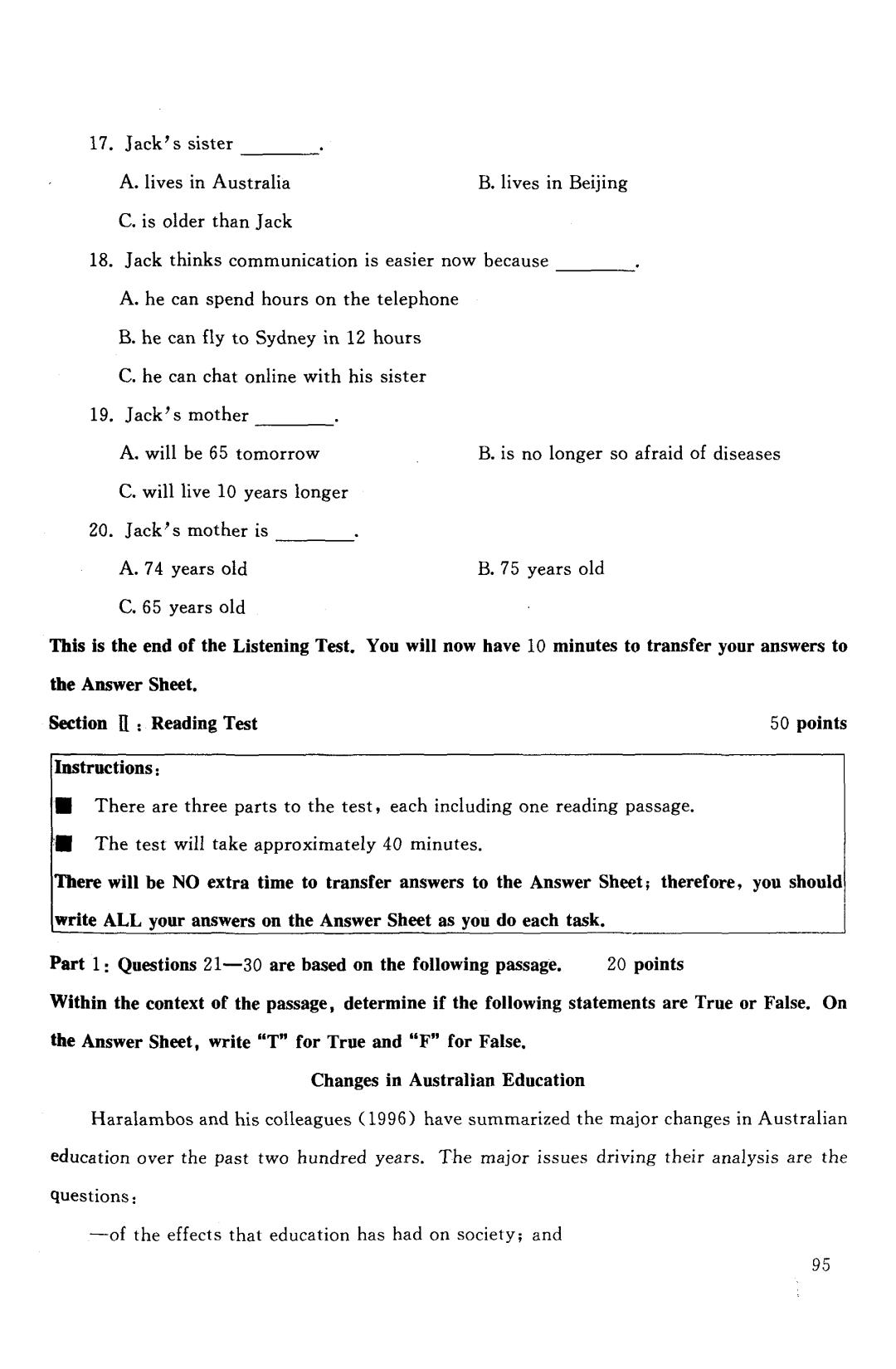
17.Jack's sister A.lives in Australia B.lives in Beijing C.is older than Jack 18.Jack thinks communication is easier now because A.he can spend hours on the telephone B.he can fly to Sydney in 12 hours C.he can chat online with his sister 19.Jack's mother A.will be 65 tomorrow B.is no longer so afraid of diseases C.will live 10 years longer 20.Jack's mother is A.74 years old B.75 years old C.65 years old This is the end of the Listening Test.You will now have 10 minutes to transfer your answers to the Answer Sheet. Section I:Reading Test 50 points Instructions: There are three parts to the test,each including one reading passage. The test will take approximately 40 minutes. There will be NO extra time to transfer answers to the Answer Sheet;therefore,you should write ALL your answers on the Answer Sheet as you do each task. Part 1:Questions 21-30 are based on the following passage. 20 points Within the context of the passage,determine if the following statements are True or False.On the Answer Sheet,write "T"for True and "F"for False. Changes in Australian Education Haralambos and his colleagues (1996)have summarized the major changes in Australian education over the past two hundred years.The major issues driving their analysis are the questions: -of the effects that education has had on society;and 95
50 points • B. is no longer so afraid of diseases B. lives in Beijing B. 75 years old • 17. • Jack' s sister A. lives in Australia c. is older than Jack 18. Jack thinks communication is easier now because A. he can spend hours on the telephone B. he can fly to Sydney in 12 hours C. he can chat online with his sister 19. lack's mother A. will be 65 tomorrow C. willlive 10 years longer 20. lack's mother is A. 74 years old C. 65 years old This is the end of the Listening Test. You will now have 10 minutes to transfer your answers to the Answer Sheet. Section II : Reading Test IInstruc伽ns ι. There are three parts to the test , each including one reading passage. I:. The test will take approximately 40 minutes. There will be NO extra time to transfer answers to the Answer Sheet; therefore , you should write ALL your answers on the Answer Sheet as you do each task. Part 1: Qu臼tions 21-30 are based on the following passage. 20 points Within the context of the pas determine if the following statements are True or False. On the Answer Sheet, write "T" for True and "F" for False. Changes in Australian Education Haralambos and his colleagues (1996) have summarized the major changes in Australian education over the past two hundred years. The major issues driving their analysis are the questIOns: -of the effects that education has had on society; and 95
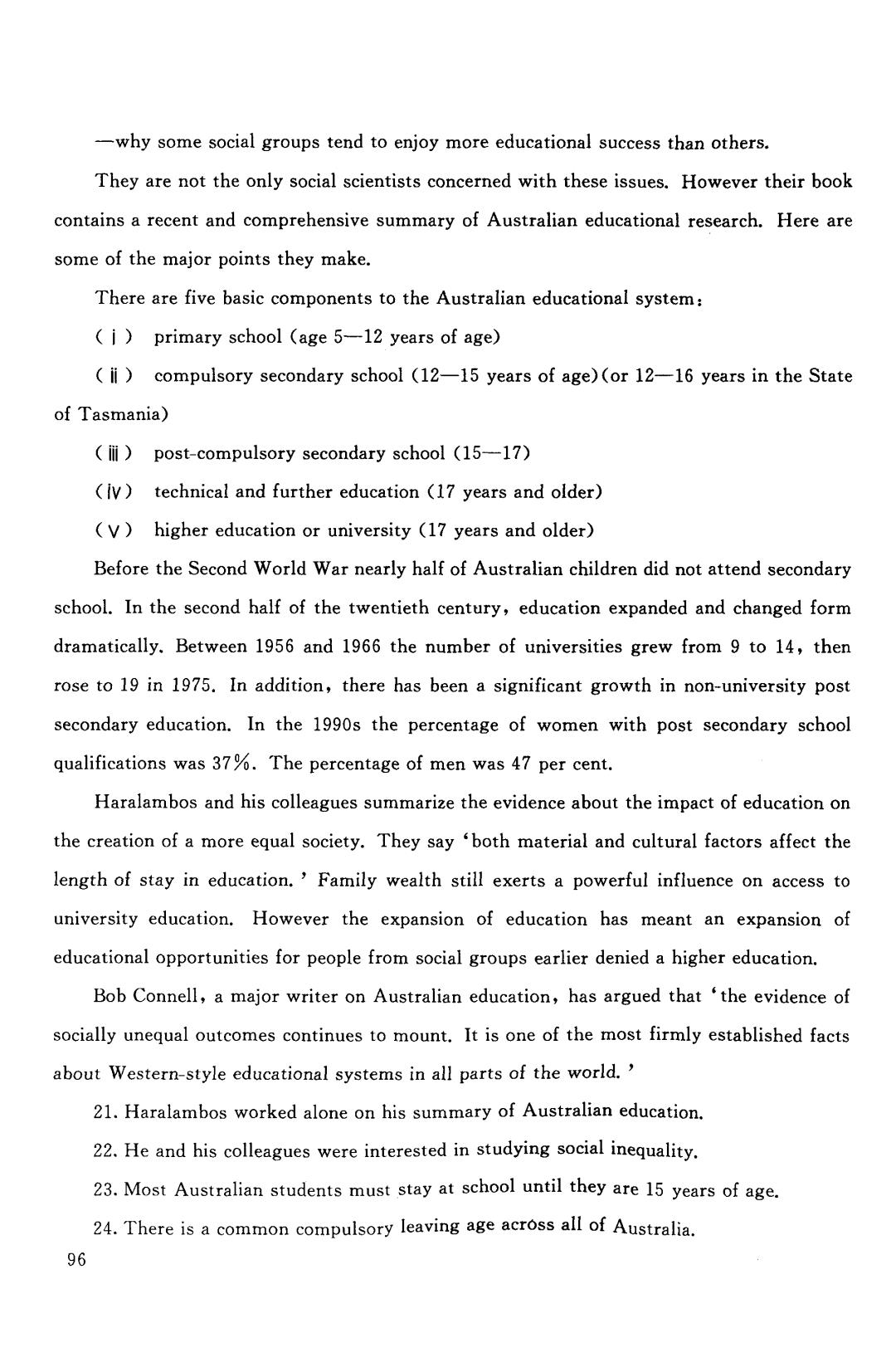
-why some social groups tend to enjoy more educational success than others. They are not the only social scientists concerned with these issues.However their book contains a recent and comprehensive summary of australian educational research.Here are some of the major points they make. There are five basic components to the australian educational system: (j primary school (age 5-12 years of age) ii)compulsory secondary school (12-15 years of age)(or 12-16 years in the State of Tasmania) (il post-compulsory secondary school (15-17) (iv)technical and further education (17 years and older) (V)higher education or university (17 years and older) Before the Second World War nearly half of Australian children did not attend secondary school.In the second half of the twentieth century,education expanded and changed form dramatically.Between 1956 and 1966 the number of universities grew from 9 to 14,then rose to 19 in 1975.In addition,there has been a significant growth in non-university post secondary education.In the 1990s the percentage of women with post secondary school qualifications was 37%.The percentage of men was 47 per cent. Haralambos and his colleagues summarize the evidence about the impact of education on the creation of a more equal society.They say 'both material and cultural factors affect the length of stay in education.Family wealth still exerts a powerful influence on access to university education.However the expansion of education has meant an expansion of educational opportunities for people from social groups earlier denied a higher education. Bob Connell,a major writer on Australian education,has argued that 'the evidence of socially unequal outcomes continues to mount.It is one of the most firmly established facts about Western-style educational systems in all parts of the world.' 21.Haralambos worked alone on his summary of Australian education. 22.He and his colleagues were interested in studying social inequality. 23.Most Australian students must stay at school until they are 15 years of age. 24.There is a common compulsory leaving age across all of Australia. 96
-why some social groups tend to enjoy more educational success than others. They are not the only social scientists concerned with these issues. However their book contains a recent and comprehensive summary of Australian educational research. Here are some of the major points they make. There are five basic components to the Australian educational system: ( i) primary school (age 5-12 years of age) ( ii) compulsory secondary school (12- 15 years of age)(or 12-16 years in the State of Tasmania) (ωiii post-compulsory secondary school (1 ( iv ) technical and further education (17 years and older) ( V ) higher education or university (17 years and older) Before the Second WarId War nearly half of Australian children did not attend secondary school. In the second half of the twentieth century , education expanded and changed form dramatically. Between 1956 and 1966 the number of universities grew from 9 to 14 , then rose to 19 in 1975. In addition , there has been a significant growth in non-university post secondary education. In the 1990s the percentage of women with post secondary school qualifications was 37%. The percentage of men was 47 per cent. Haralambos and his colleagues summarize the evidence about the impact of education on the creation of a more equal society. They say ‘ both material and cultural factors affect the length of stay in education. ' Family wealth still exerts a powerful influence on access to university education. However the expansion of education has meant an expansion of educational opportunities for people from social groups earlier denied a higher education. Bob Connell , a major writer on Australian education , has argued that ‘ the evidence of socially unequal outcomes continues to mount. It is one of the most firmly established facts about Western-style educational systems in all parts of the world. ' 21. Haralambos worked alone on his summary of Australian education. 22. He and his colleagues were interested in studying social inequality. 23. Most Australian students must stay at school until they are 15 years of age. 24. There is a common compulsory leaving age across all of Australia. 96